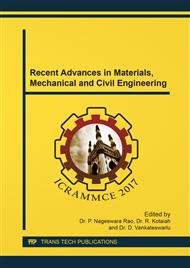[1]
W. Zhou and Z.M. Xu, Casting of SiC reinforced metal matrix composites, Journal of Materials Processing Technology; vol. 63, no. 1–3, p.358–363, (1997).
DOI: 10.1016/s0924-0136(96)02647-7
Google Scholar
[2]
A. R. Ahamed, P. Asokan, S. Aravindan, and M. K. Prakash, Drilling of hybrid Al-5%SiCp-5%B4Cp metal matrix composites, International Journal of Advanced Manufacturing Technology; vol. 49, no. 9–12, p.871–877, (2010).
DOI: 10.1007/s00170-009-2453-5
Google Scholar
[3]
J. Peronczyk and J. Kozak, Electrical discharge machining (EDM) of the metal matrix composites (MMC), in Proceedings of the 8th International Conference on Rotary Fluid- flow Machines, p.391, Rzeszow-Bystre, Krakow, Poland, (1998).
Google Scholar
[4]
B. H. Yan, C. C. Wang, W. D. Liu, and F. Y. Huang, Machining characteristics of Al2O3/6061Al composite using rotary EDM with a disk like electrode, International Journal of Advanced Manufacturing Technology; vol. 16, no. 5, p.322–333, (2000).
DOI: 10.1007/s001700050164
Google Scholar
[5]
P. N. Singh, K. Raghukandan, and B. C. Pai, Optimization by Grey relational analysis of EDM parameters on machining Al- 10%SiCP composites, Journal of Materials Processing Technology; vol. 155-156, no. 1–3, p.1658–1661, (2004).
DOI: 10.1016/j.jmatprotec.2004.04.322
Google Scholar
[6]
R. Karthikeyan, P. R. Lakshmi Narayanan, andR. S. Naagarazan, Mathematical modelling for electric discharge machining of aluminium-silicon carbide particulate composites, Journal of Materials Processing Technology; vol. 87, no. 1–3, p.59–63, (1999).
DOI: 10.1016/s0924-0136(98)00332-x
Google Scholar
[7]
J. L. Lin and C. L. Lin, The use of the orthogonal array with grey relational analysis to optimize the electrical discharge machining process with multiple performance characteristics, International Journal of Machine Tools and Manufacture; vol. 42, no. 2, p.237–244, (2002).
DOI: 10.1016/s0890-6955(01)00107-9
Google Scholar
[8]
B. Mohan, A. Rajadurai, and K. G. Satyanarayana, Effect of SiC and rotation of electrode on electric discharge machining of Al-SiC composite, Journal of Materials Processing Technology; vol. 124, no. 3, p.297–304, (2002).
DOI: 10.1016/s0924-0136(02)00202-9
Google Scholar
[9]
S. T. Kumaran and M. Uthayakumar, Investigation on the machining studies of AA6351-SiC-B4C hybrid metal matrix composites, International Journal of Machining and Machinability of Materials; vol. 15, no. 3-4, p.174–185, (2014).
DOI: 10.1504/ijmmm.2014.060548
Google Scholar
[10]
10.R. K. Bhusan, Optimization of cutting parameters for minimizing power consumption and maximizing tool life during machining of Al alloy SiC particle composites, Journal of Cleaner Production; vol. 39, p.242–254, (2012).
DOI: 10.1016/j.jclepro.2012.08.008
Google Scholar
[11]
A. Aggarwal, H. Singh, P. Kumar, and M. Singh, Optimizing power consumption for CNC turned parts using response surface methodology and Taguchi's technique-a comparative analysis, Journal of Materials Processing Technology; vol. 200, no. 1–3, p.373–384, (2008).
DOI: 10.1016/j.jmatprotec.2007.09.041
Google Scholar
[12]
S. T. Kumaran and M. Uthayakumar, Investigation on the dry sliding friction and wear behavior of AA6351-SiC-B4C hybrid metal matrix composites, Proceedings of the Institution of Mechanical Engineers J: Journal of Engineering Tribology; vol. 228, no. 3, p.332–338, (2014).
DOI: 10.1177/1350650113508103
Google Scholar
[13]
A. N. Haq, P. Marimuthu, and R. Jeyapaul, Multi response optimization of machining parameters of drilling Al/SiC metal matrix composite using grey relational analysis in the Taguchi method, International Journal of Advanced Manufacturing Technology: vol. 37, no. 3-4, p.250–255, (2008).
DOI: 10.1007/s00170-007-0981-4
Google Scholar


